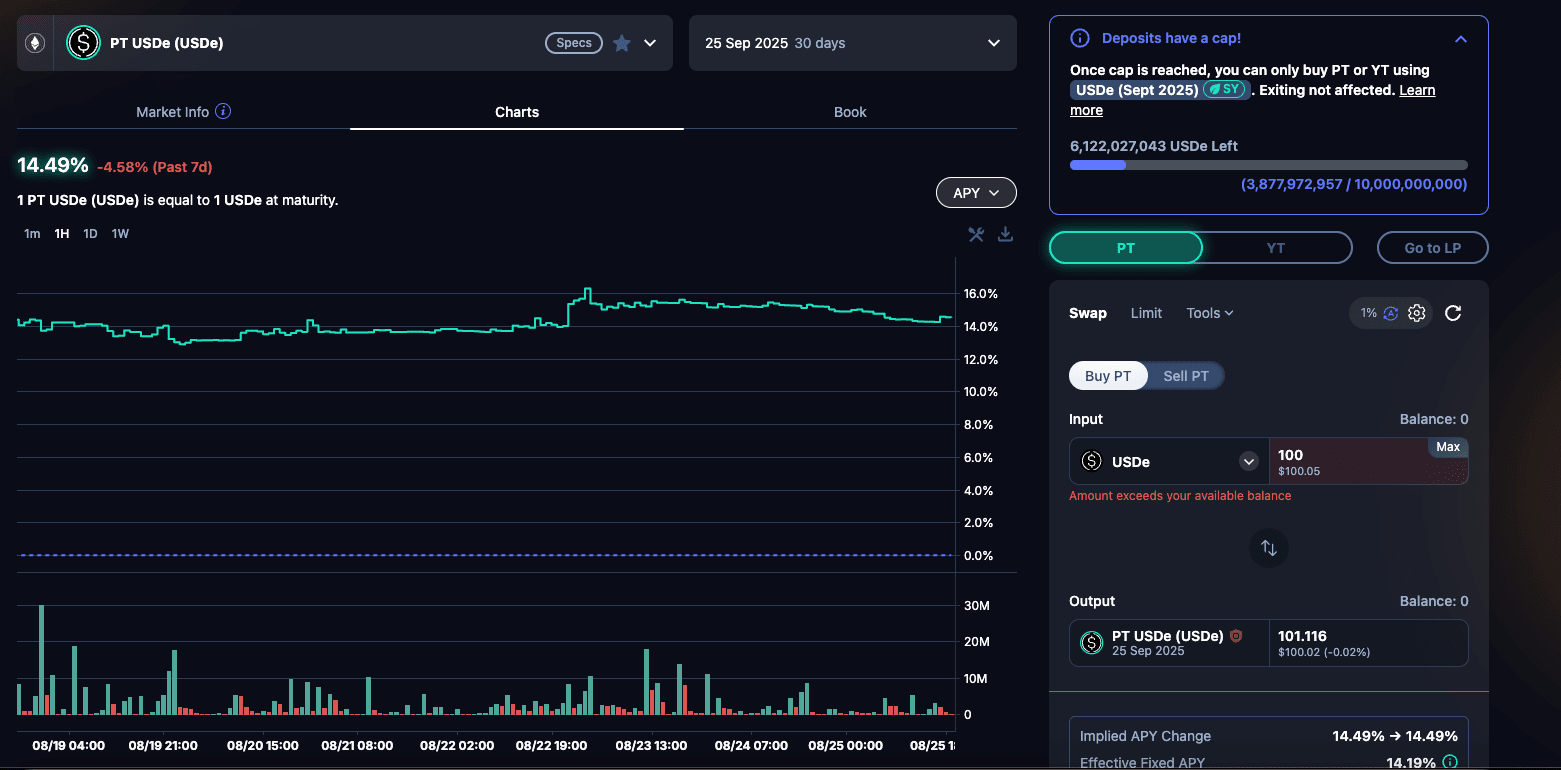In traditional finance, high leverage is regarded as no different from gambling. The fundamental reason is that the higher the leverage, the greater the probability of liquidation. In the ever-changing financial market, even if the direction is judged correctly, a sudden correction with the blessing of high leverage is enough to lose all the principal.
So, if there is a brand-new protocol in the field of DeFi that can perfectly compatible the two attributes of high leverage and no liquidation, is this possible?
Pendle, which will be introduced in this article, magically decomposes the basic yield-bearing assets into two tradable tokens, PT (Principal Token) and YT (Yield Token), with unparalleled ingenuity. This achieves the financial myth of 'high leverage without liquidation'.
1. Pendle's Magic: Tokenization and Stripping of Yield-Bearing Assets
To understand Pendle, you first need to understand its relationship with technical protocols represented by AAVE. For example, AAVE provides the raw materials for generating interest - aToken, and Pendle refines these raw materials.
A typical processing flow with AAVE and ETH as an example is as follows:
Basic Layer: Investors deposit ETH in AAVE, thereby obtaining the same amount of equity tokens aETH, which has dual attributes, representing both the principal amount and automatically accumulating interest over time.
Tokenization: When investors deposit aETH into Pendle, Pendle encapsulates it into a unified internal token called SY - aETH through a standardized layer called SY (Standardized Yield). This ensures that Pendle can be compatible with yield-bearing assets from different protocols.
Stripping: This is Pendle's core innovation. Through stripping operations, SY - aETH will be divided into two, generating equal amounts of PT - aETH and YT - aETH. Two identities are generated here.
1) SY = PT+YT (Value Relationship)
2) PT = YT (Quantity Relationship)
Among them
1) PT (Principal Token): Represents the principal part of the underlying asset. The value of PT lies in the commitment to redeem the original asset at a fixed ratio of 1:1 at a certain point in the future (maturity date);
2) YT (Yield Token): Represents all the 'floating yields' generated by the underlying asset before the maturity date.

USDe is stripped into PT and YT.
This process is similar to stripping bonds in traditional finance. In the traditional market, the principal and interest portions of government bonds can be stripped into independent securities for trading. Pendle brought this practice into DeFi, and further stripped assets that generate floating interest rates (usually the interest rate of government bonds is fixed). Let's go back to the identity SY = PT + YT, and we can find that this equation ensures that at any time, the value of the two tokens that are stripped out is equal to the underlying asset it represents, which is also the underlying mathematical principle of the Pendle protocol.
2. Self-Liquidating Loss: The Secret of High Leverage Without Liquidation
As mentioned above, in traditional finance, high leverage and no liquidation are almost mutually exclusive concepts. However, Pendle can perfectly compatible both at the same time. The magic behind it comes from a unique risk model.
Taking AAVE as an example, if leverage is used on it, investors must pledge assets and borrow other assets. If the value of the collateral decreases and reaches a certain threshold, the protocol will trigger forced liquidation, sell the collateral and repay the debt, resulting in the investor losing the principal.
Pendle's YT leverage is completely different because it does not have a 'borrowing relationship', so it will not be liquidated. So how is YT's leverage achieved?
The Essence of Leverage: YT's leverage is different from the traditional one. It should be called the leverage effect. The effect comes from its extremely low cost. Because YT only represents the yield part of the asset, investors only need to spend a small amount of money to buy YT to obtain all the yields corresponding to its underlying asset. This is essentially speculation on future interest rates.
The Secret of No Liquidation: YT's risk model is very different from the traditional liquidation model. It is called the 'Self-Liquidating' model. The value of YT will gradually decay over time and become zero on the maturity date, because its 'future yield' value has been exhausted. This means that even if the price of YT purchased by the investor plummets, the maximum loss is only the cost of purchasing YT, which will not trigger any liquidation events, and the investor's underlying assets are always safe.
It's like buying a lottery ticket. When you buy a lottery ticket with a small amount of money, if you win, the value will skyrocket. If you don't win, the value of the lottery ticket becomes zero, but the scrapped lottery ticket will not affect any of your other assets.

3. How to Choose, Buy PT or Buy YT
Through analysis, we know the different attributes of PT and YT. This difference also determines that they are suitable for different types of investors.
PT: A fixed income option for conservative investors. If you are looking for fixed income, then PT will be a very good choice. In DeFi, it can provide higher returns than traditional interest rate markets, while also avoiding the risk of market fluctuations. Because PT has been stripped of its ability to generate interest, it allows you to purchase assets at a discounted price (e.g., 5%) and redeem the full asset price upon maturity. On the maturity date, this 5% price difference is the realization of the return. That is, as long as the protocol is secure, the return on PT is always fixed regardless of market fluctuations. Even if market interest rates generally fall, the fixed income of PT will become more attractive, bringing a premium and thus additional capital gains.
YT: An interest rate speculation tool for aggressive investors. If you are one of the following types of investors, then YT will open the door to new opportunities.
1) Bullish on rising interest rates in the future: If you judge that the borrowing rate of a certain protocol will rise within a certain period of time, then YT can allow you to use a small amount of capital to obtain leveraged opportunities for high interest rates.
2) Pursuing high returns and willing to take risks for them: The price of YT is highly sensitive to interest rate expectations. If the judgment is correct, the price of YT is very likely to skyrocket in a short period of time. Conversely, if the judgment is wrong and the price of YT plummets, then you will lose at most the principal of purchasing YT.
3) Hedging needs for professionals: In some highly professional and complex investment strategies, YT can also be used to hedge the risk of interest rate fluctuations, enriching the choices of professionals.

USDe's PT purchase page, you can see the fixed APY is 14.19%.
4. Zero on Expiration: YT's Intrinsic Value and Value Decay
The value of YT consists of the following two parts
Intrinsic Value: This refers to the yield generated by the underlying yield-bearing asset represented by YT that has not yet been claimed. This part of the value will gradually accumulate over time.
Time Value: This refers to the future potential yield represented by YT. It is the core of YT's value and the source of its speculation.

Pendle's documentation clearly states that the yield can be claimed at any time before the maturity date, and the value of YT becomes zero on the maturity date.
The value change of YT mainly comes from two aspects.
Expected Interest Rate Changes: The value of YT will be affected by market fluctuations in future interest rate expectations. If the expected interest rate rises, the value of YT will also rise. If the expected interest rate falls, the value of YT will also fall.
Time Decay: Since YT represents a future yield with a limited term, its value will decrease as the maturity date approaches, and the decay will accelerate as the maturity date approaches, because the future yield it represents will become less and less, so the rate of value decline will become faster and faster, until it becomes completely zero on the maturity date.
5. Conclusion: Pendle's Contribution and the Future of DeFi
Pendle's success lies not only in its ingenious conception and design, but also in the fact that it brings three important financial tools to DeFi.
Fixed income products: The emergence of PT fills the gap in the DeFi market for safe and predictable fixed income products, attracting more conservative investors.
Interest rate derivatives: YT treats the interest rate itself as a tradable commodity, enriching the speculation and hedging strategies in the DeFi market.
Improved capital efficiency: By separating the principal and yield of the underlying yield-bearing assets through SY, Pendle enables two different investment strategies to be realized on the same asset, greatly improving capital utilization efficiency.
By disassembling and abstracting the essence of interest, Pendle explored the path to build a more complex financial layer on the basis of borrowing and lending interest. This mode of thinking led Pendle to success, and also indicates that the future DeFi will create more diverse and mature investment methods, and eventually break through the circle of encryption and form a new paradigm in the financial field.

